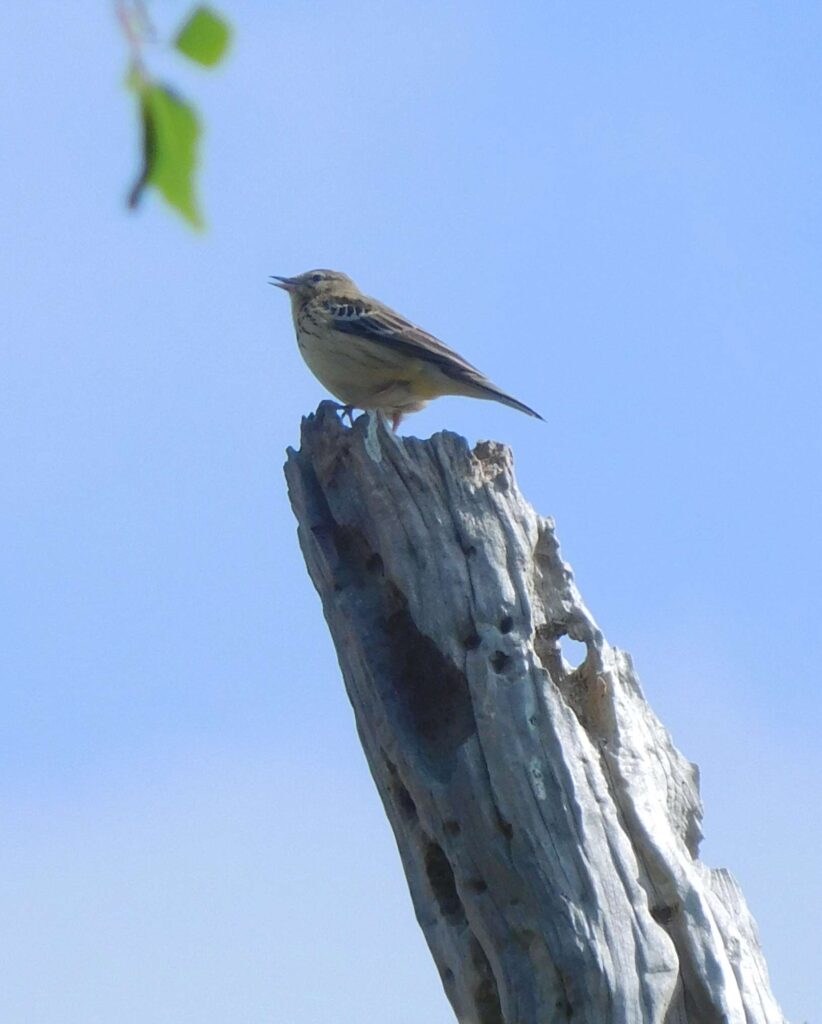
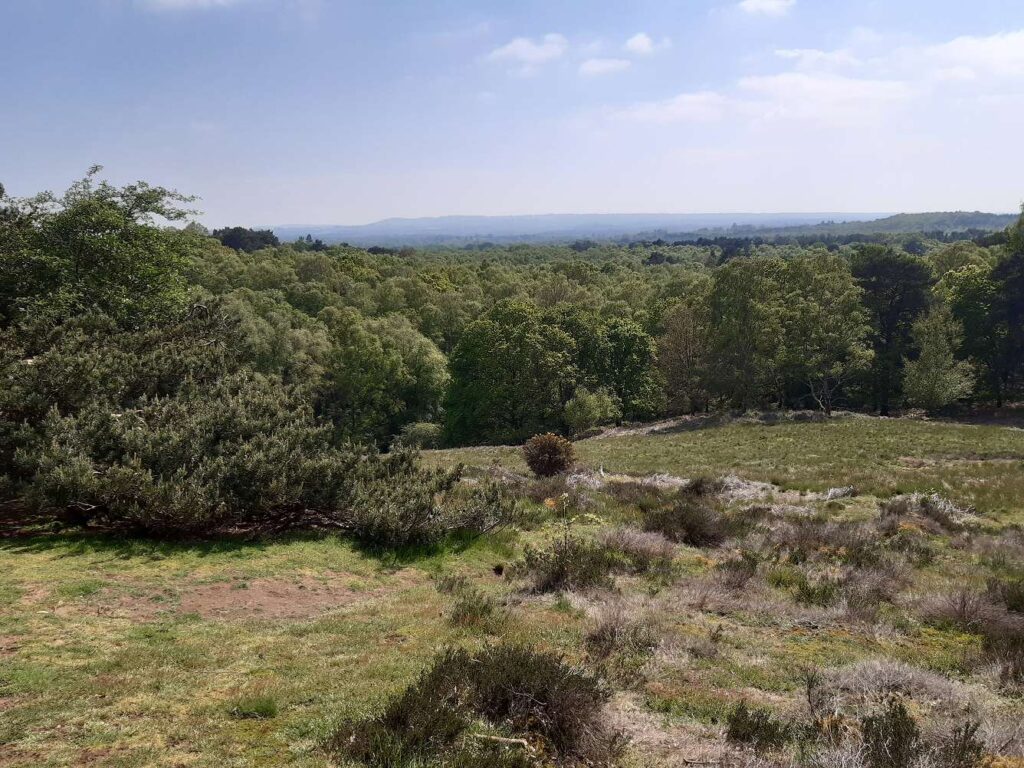
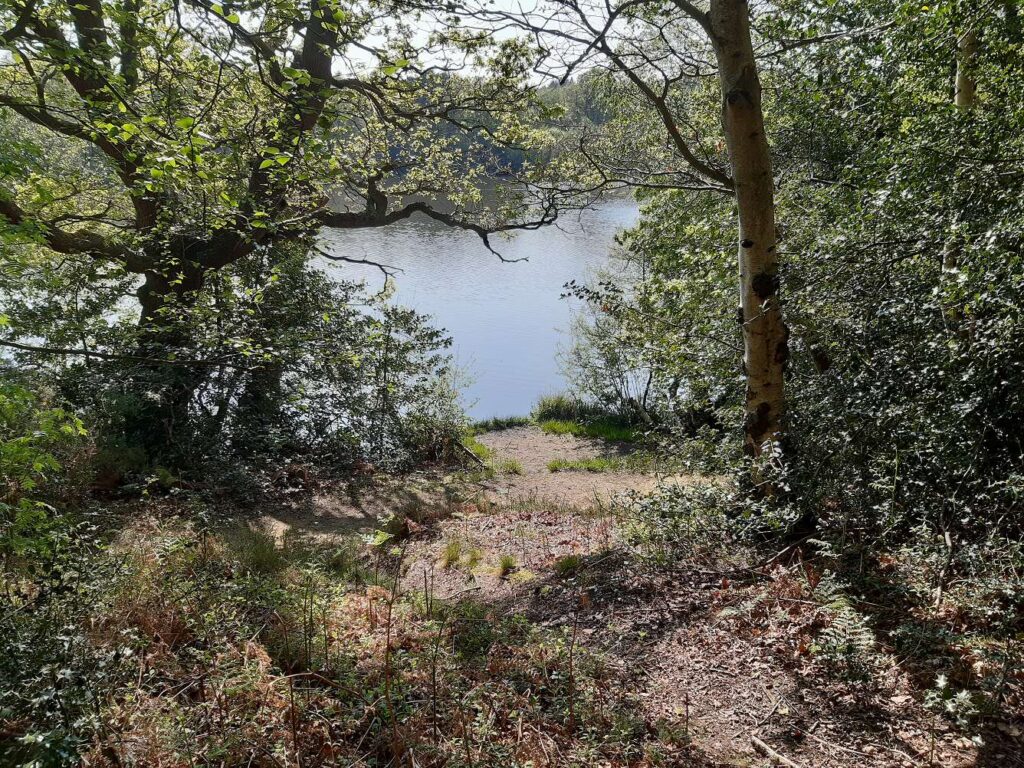
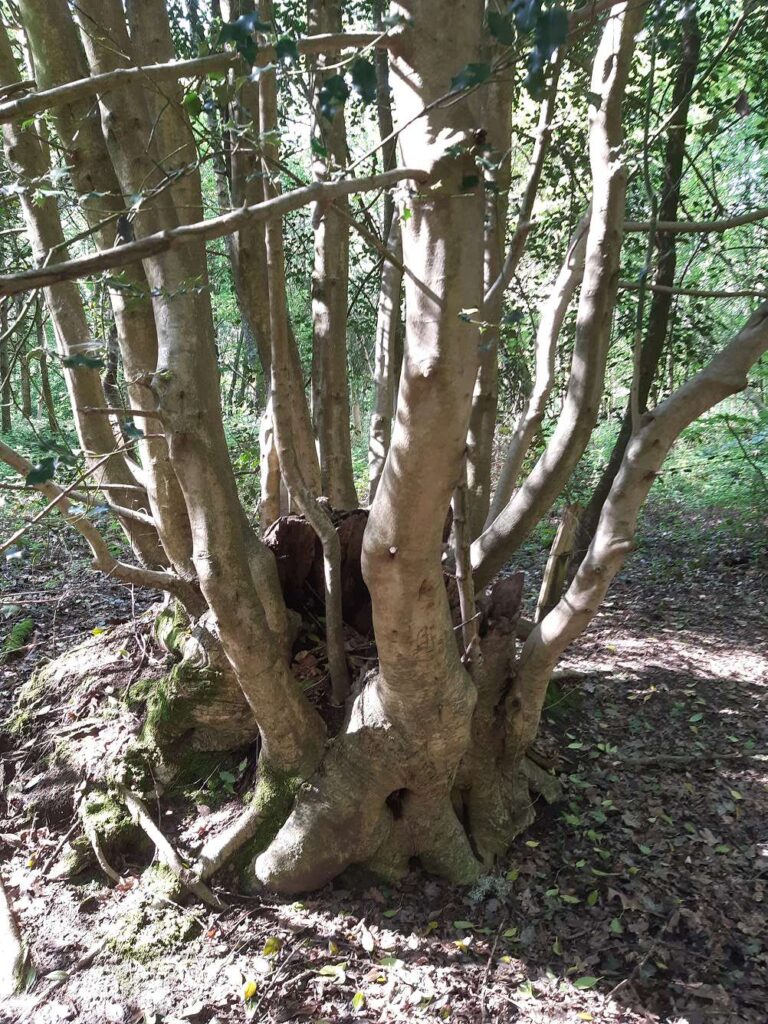
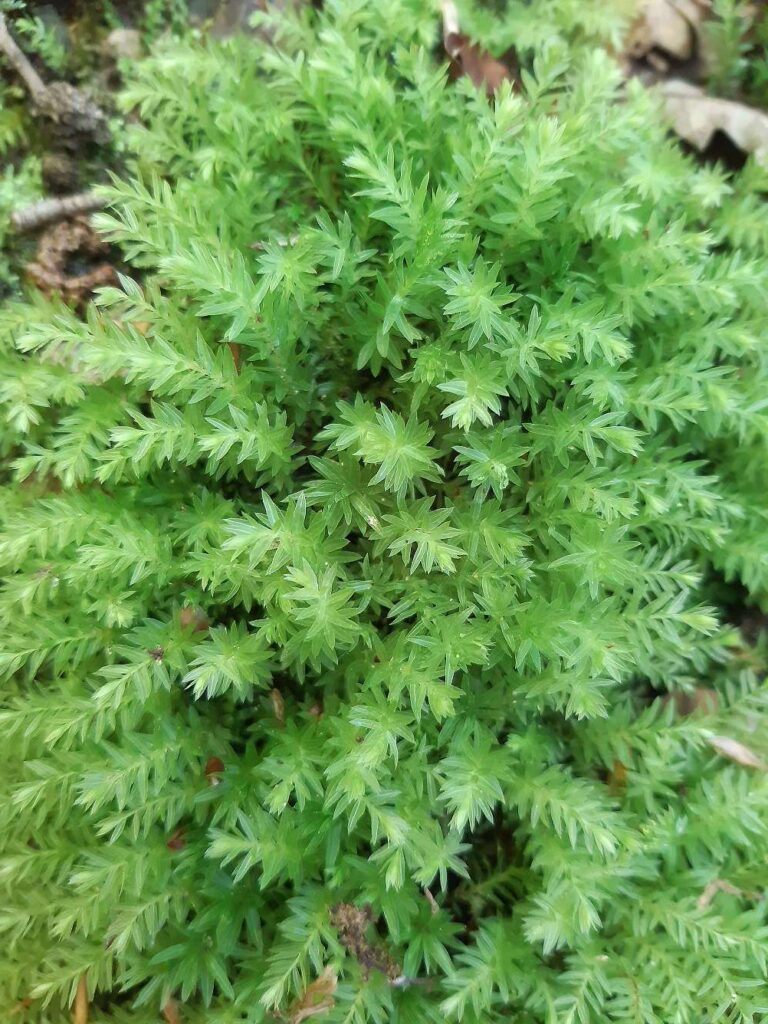
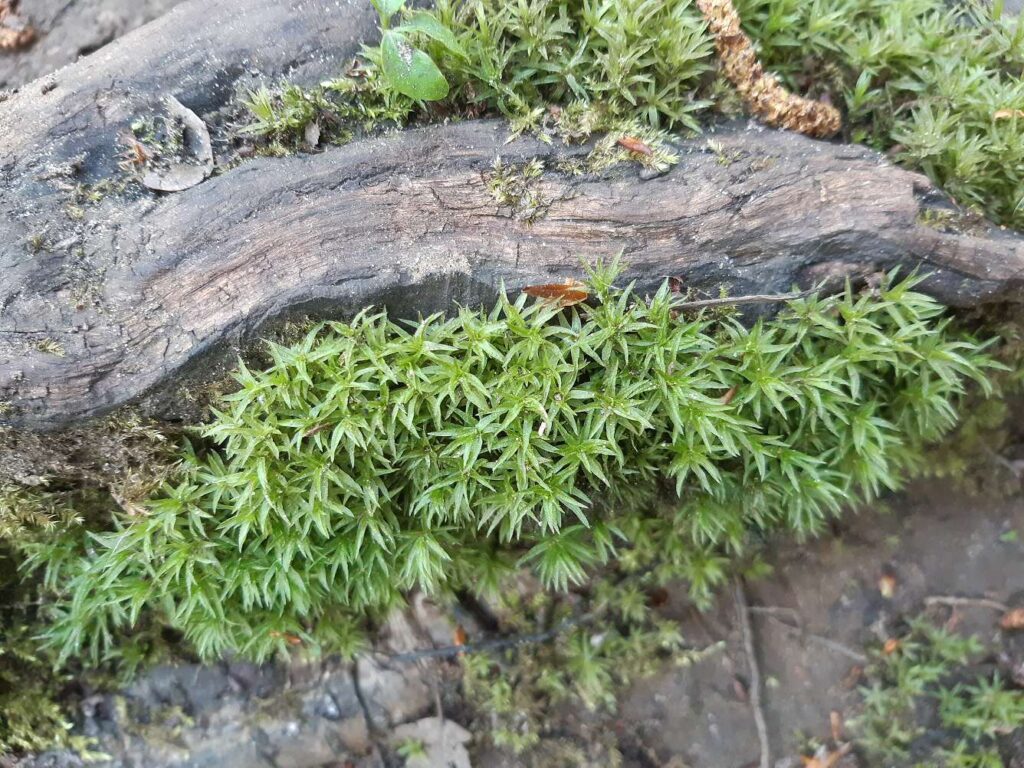






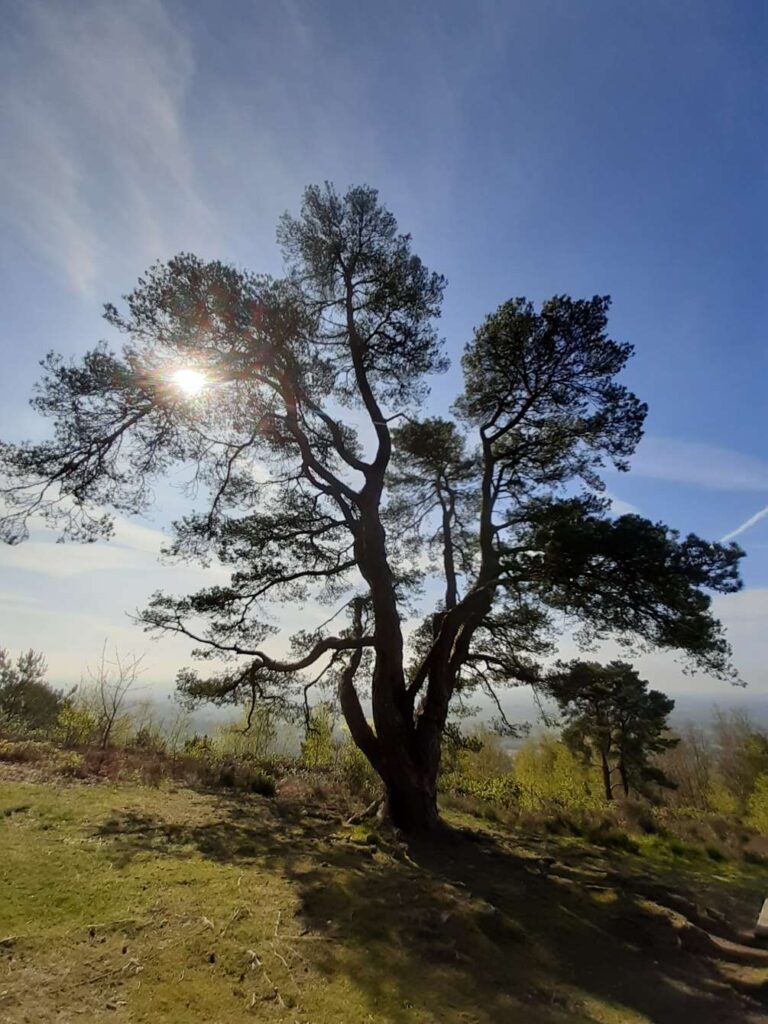
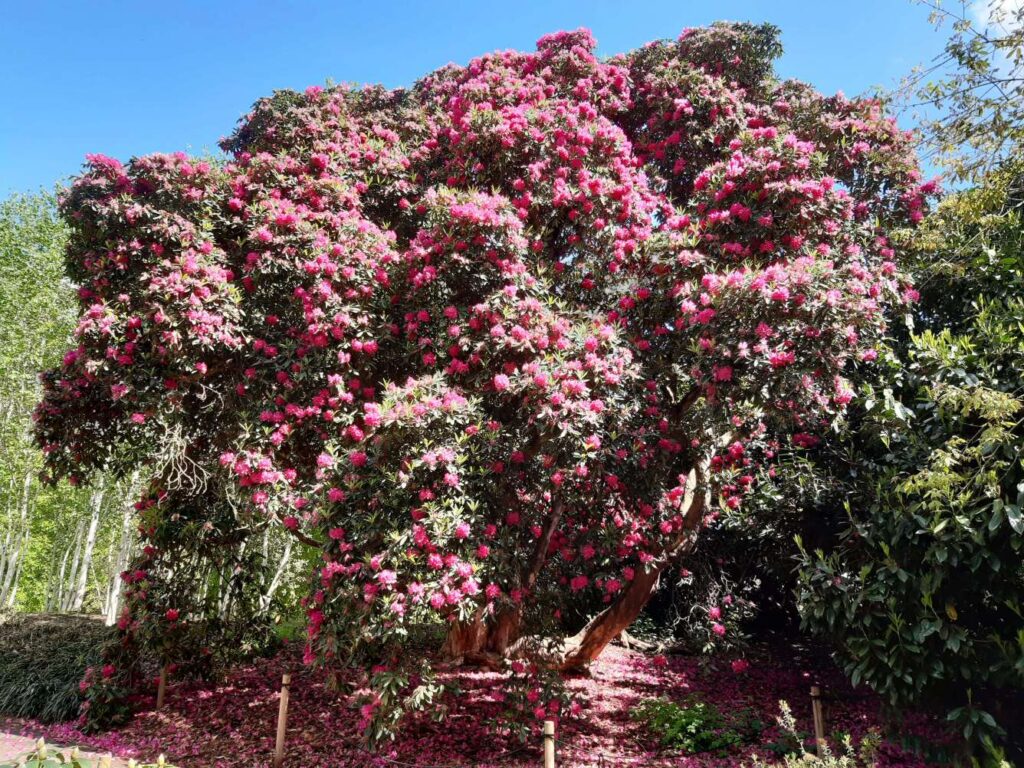
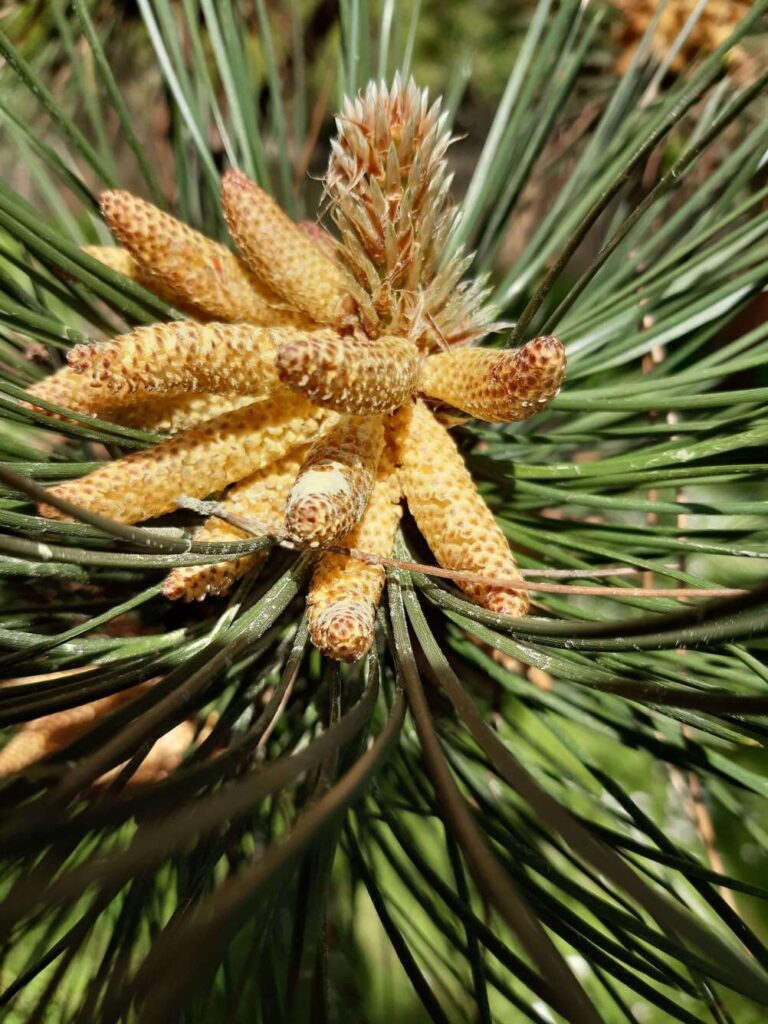
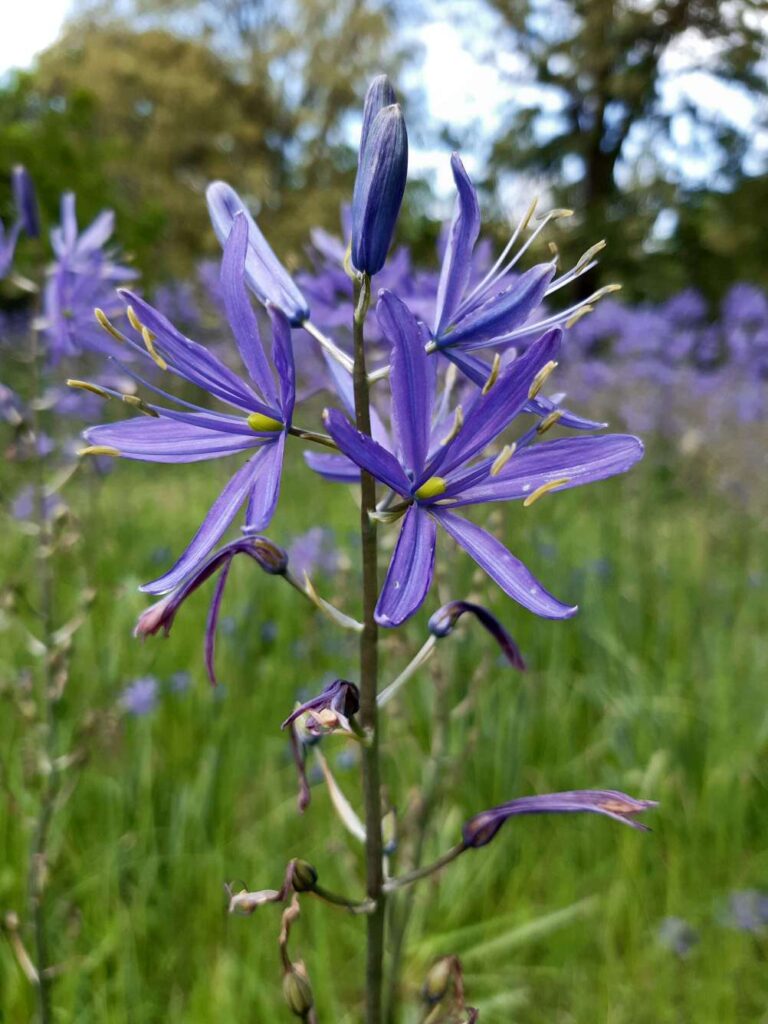
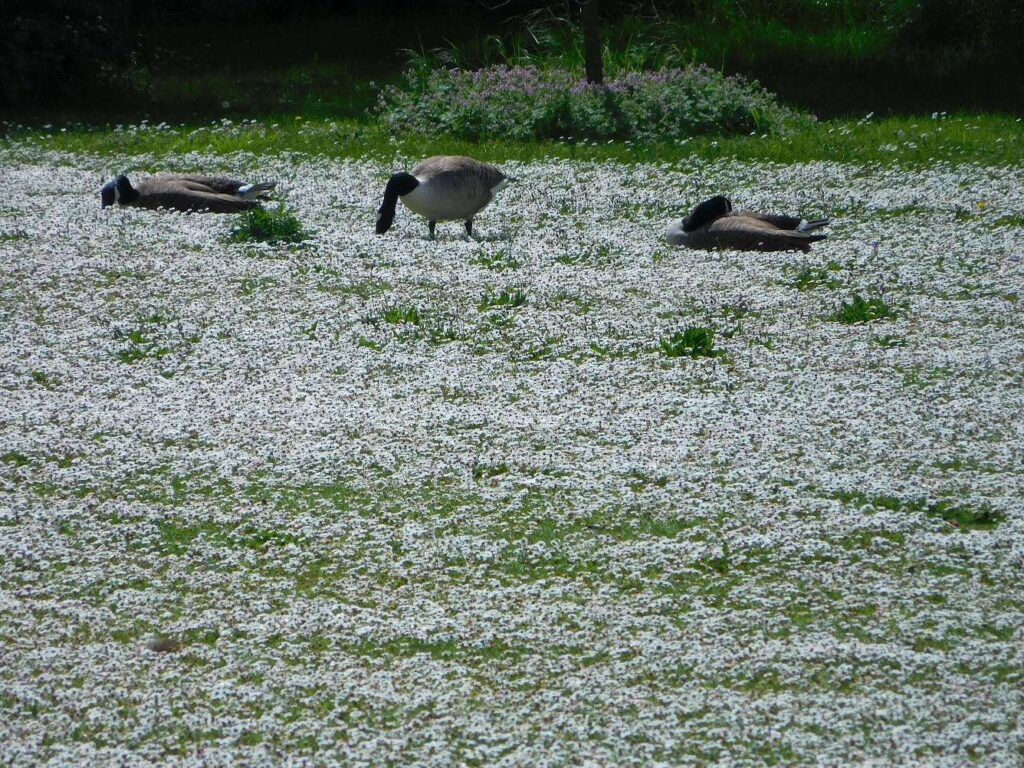
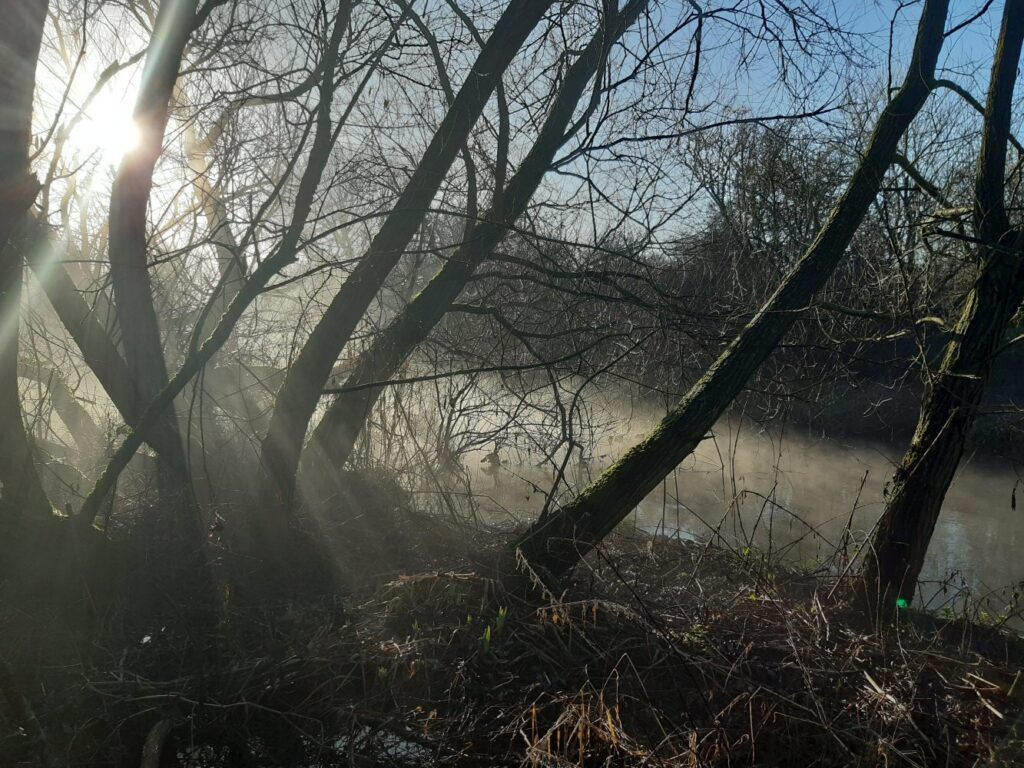
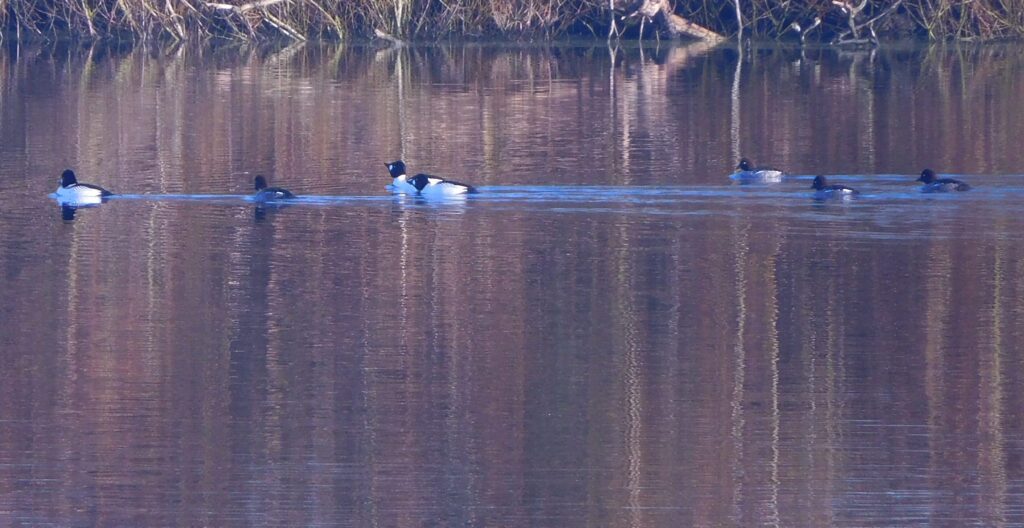
Among the wonderful moments on this walk: a heron gave its cronking call and flapped slow over the water; a plane passed behind three cormorants drying their wings, perched on the branches of a dead tree; a group of goldeneyes panicked and pattered across the lake, gaining speed for takeoff, giving their high-pitched call, the waves sparkling in the slanting sunshine; a song thrush tentatively singing its repeated music; a solitary fieldfare.
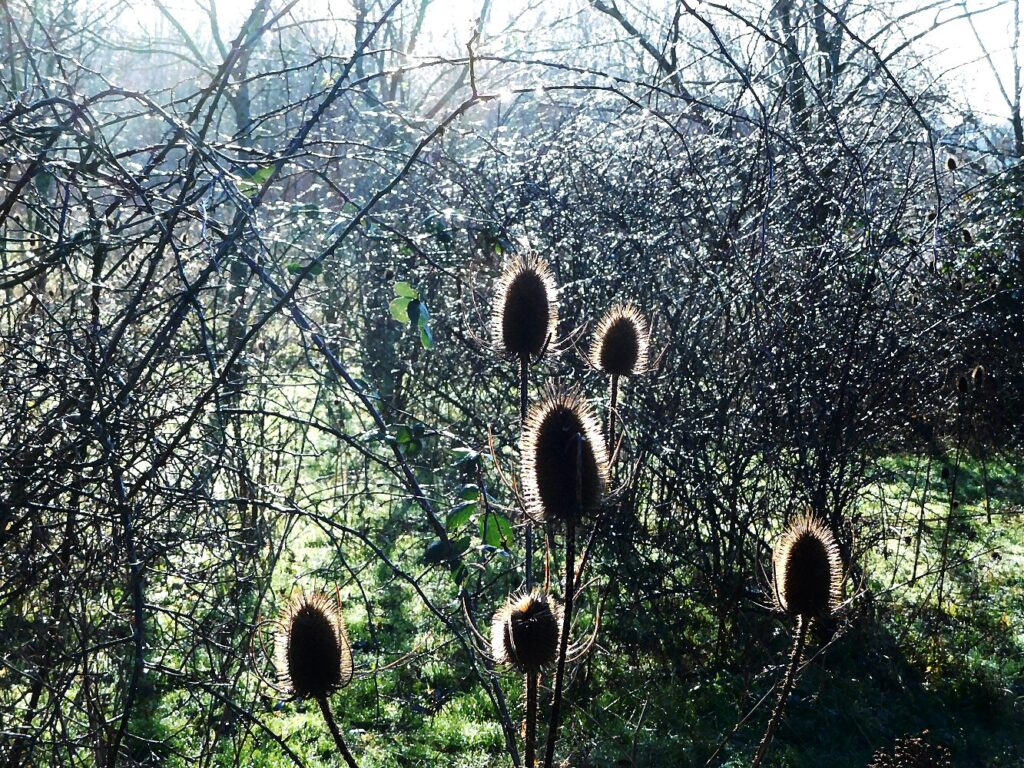
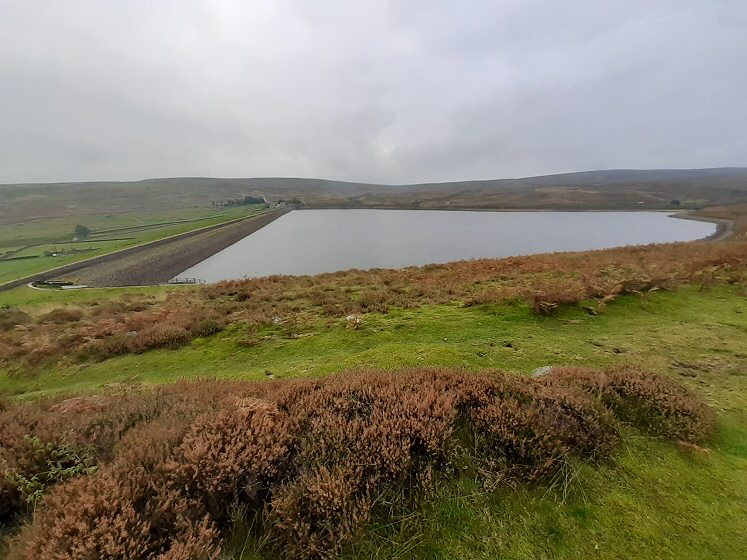
Barden Moor is an extensive water catchment area, on acidic rock (Millstone Grit), providing soft drinking water to the city of Bradford. The area is part of the ancient Bolton Abbey estate, and is now also in the Yorkshire Dales National Park. It’s covered in heather and moorgrass with areas of meadow and bog pools. It’s a fine place for an open airy walk away from the sometimes busy mountaintops, and a wonderful spot for nature.
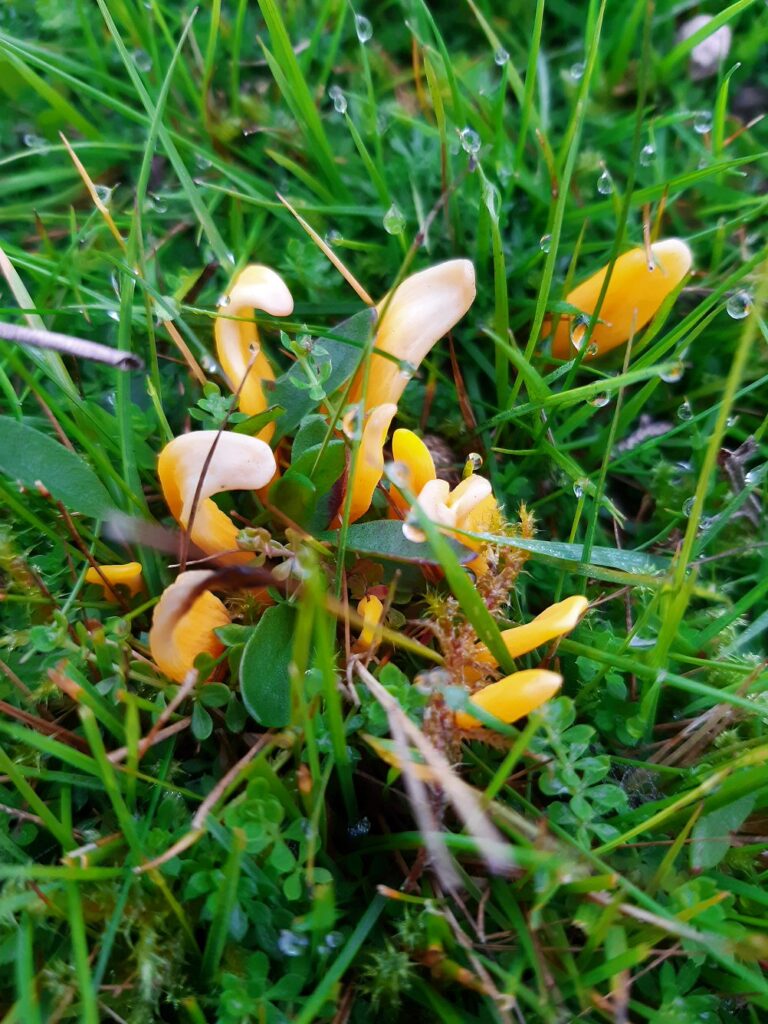
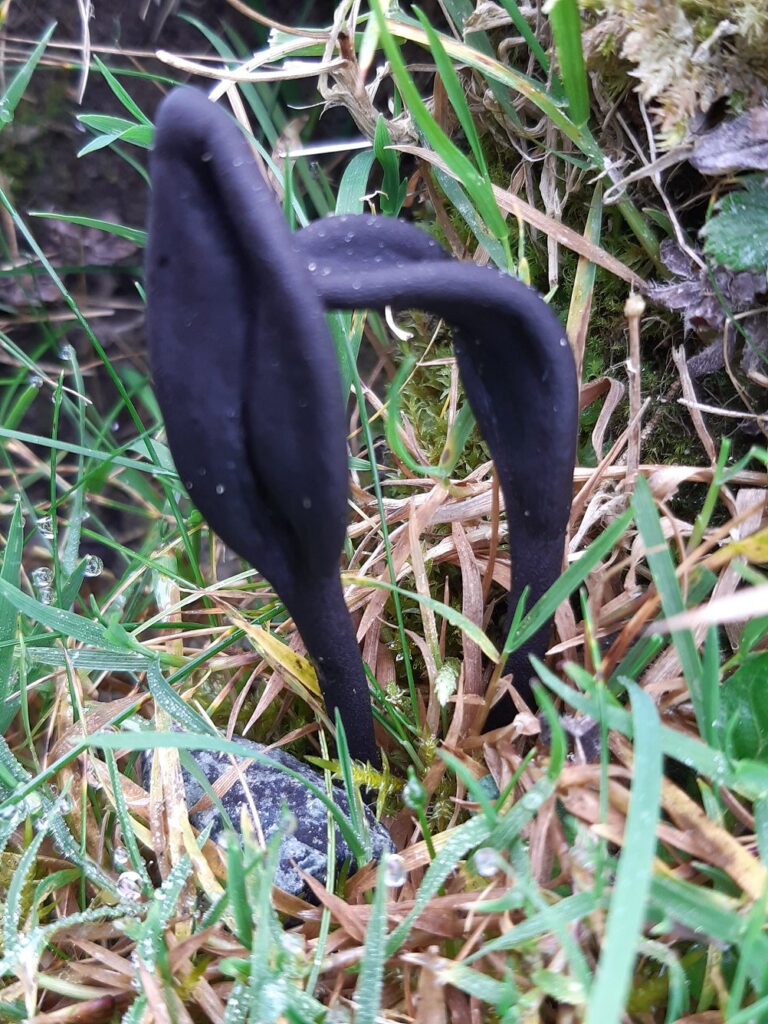
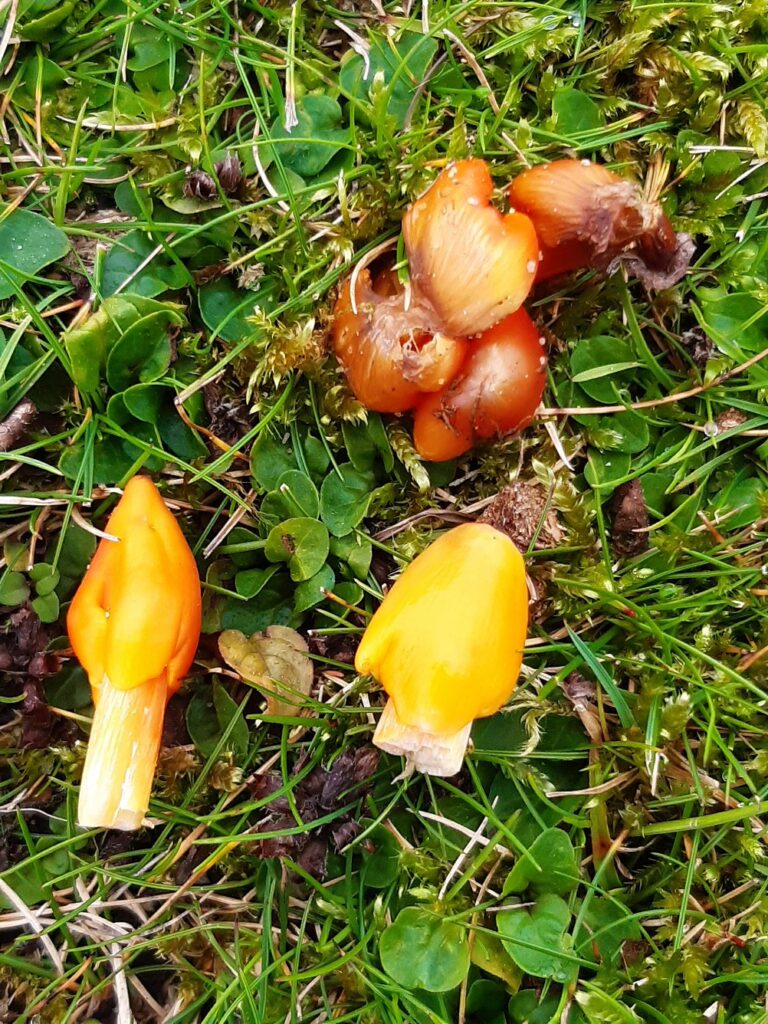
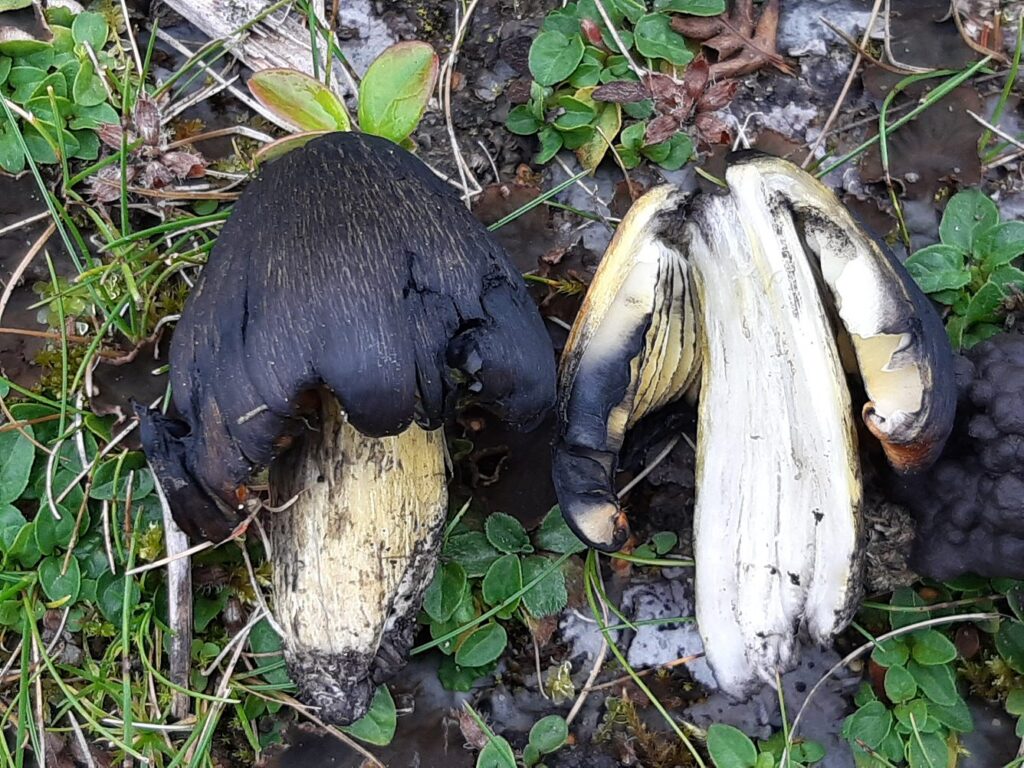
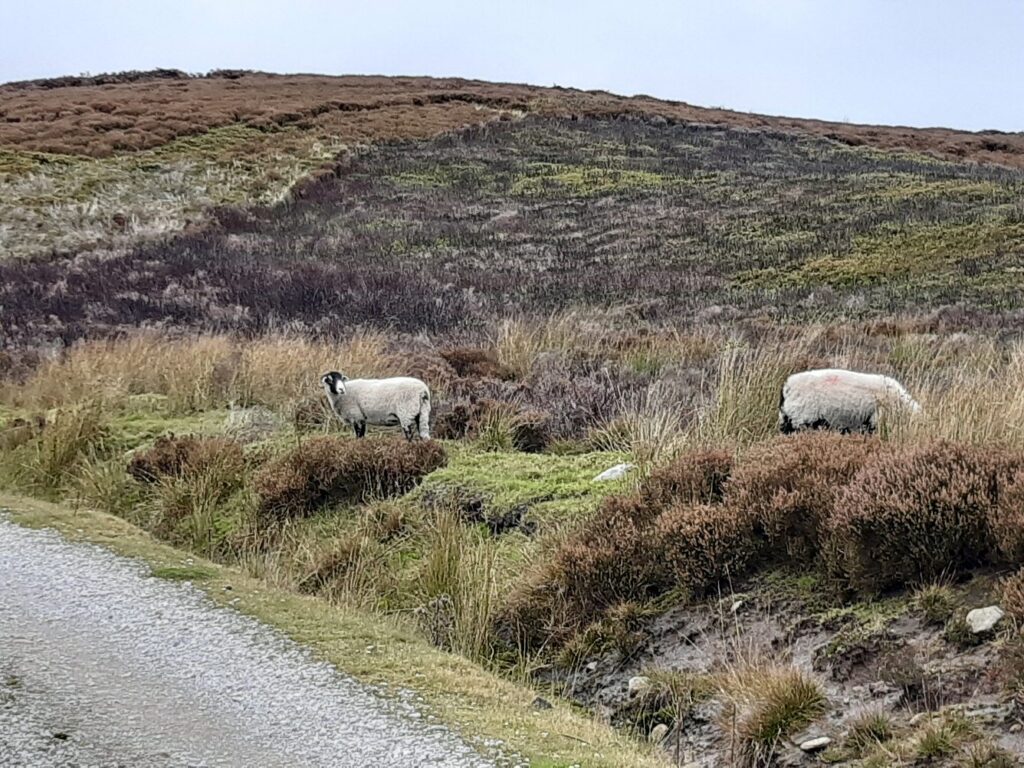
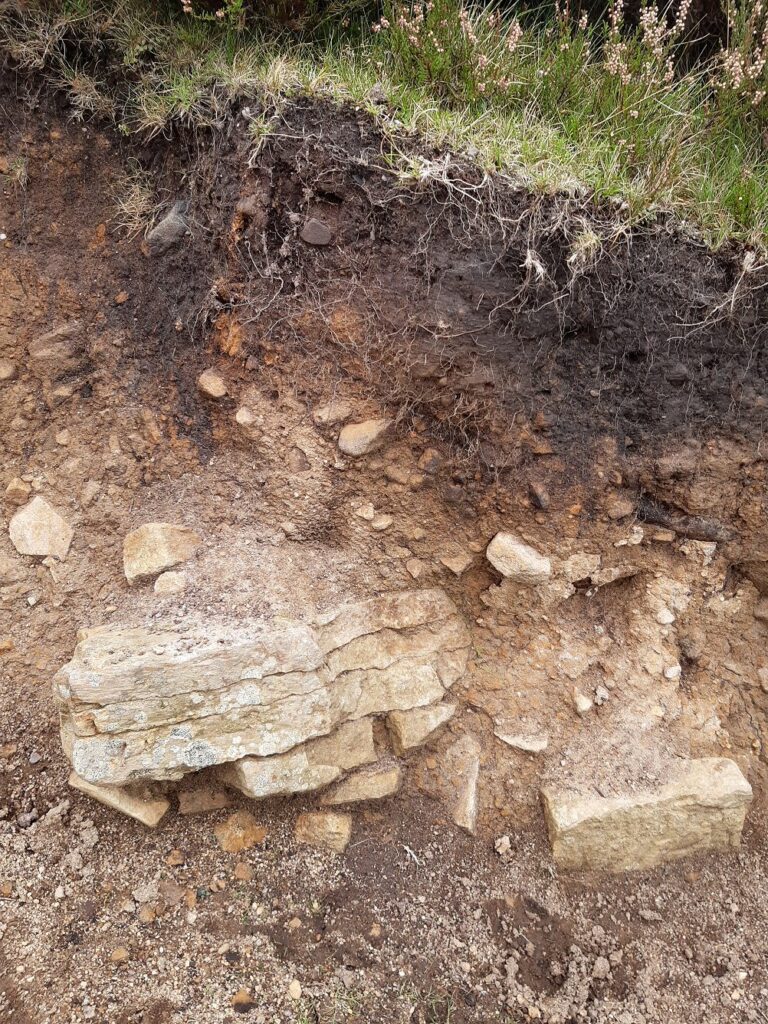
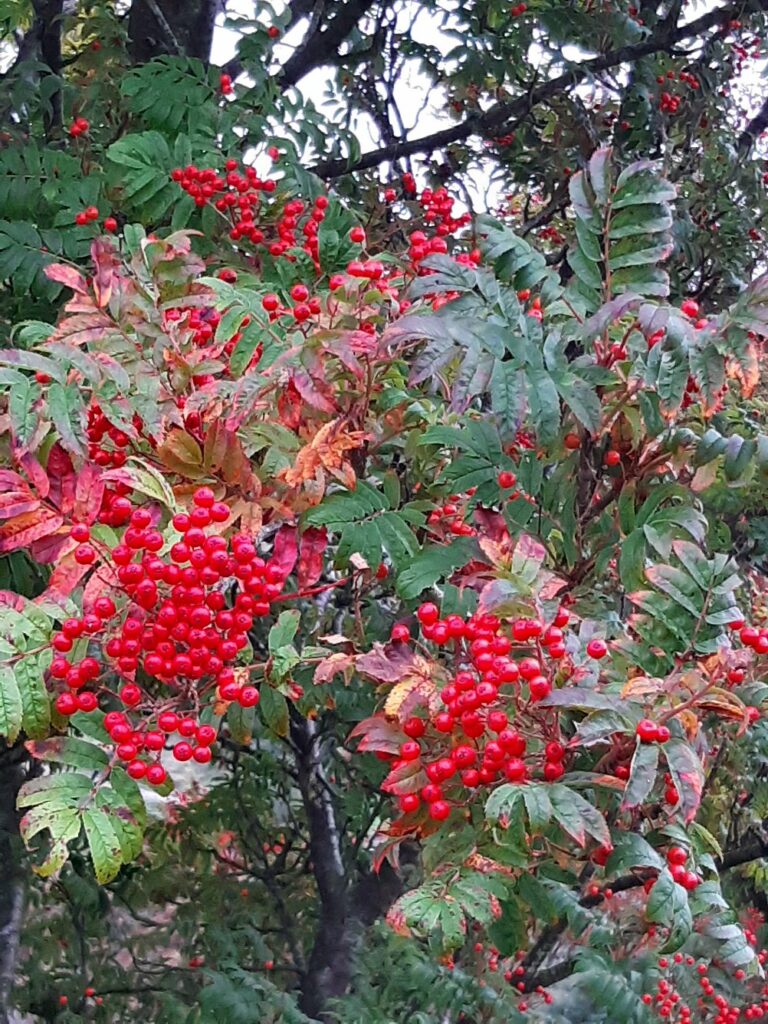
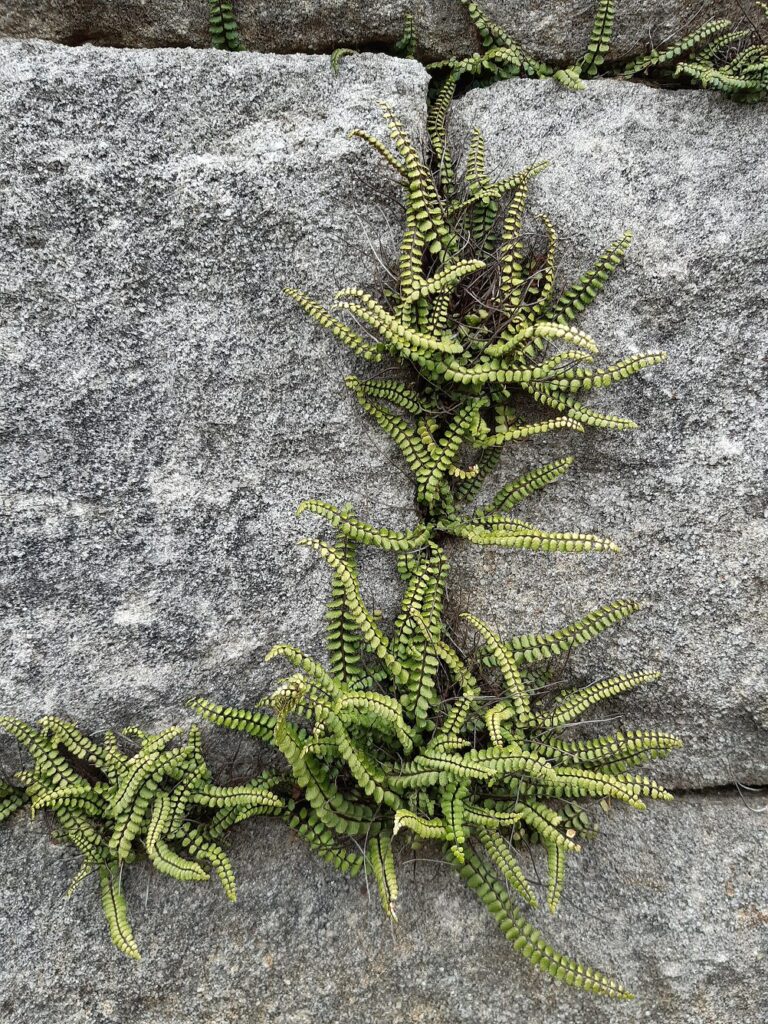
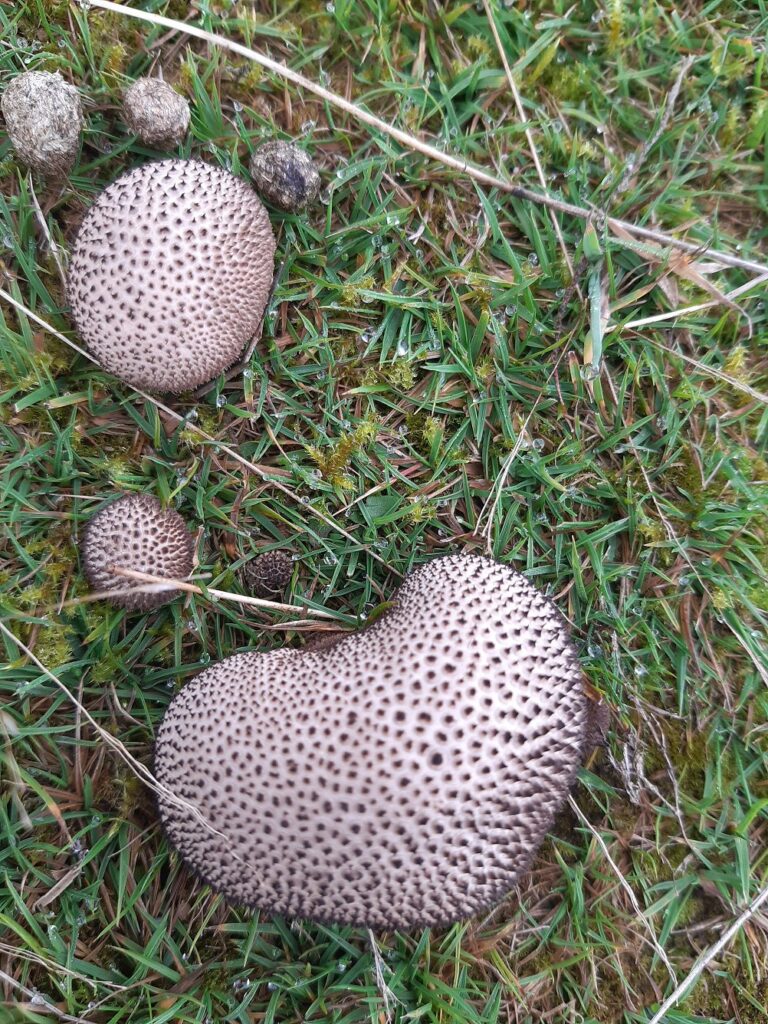
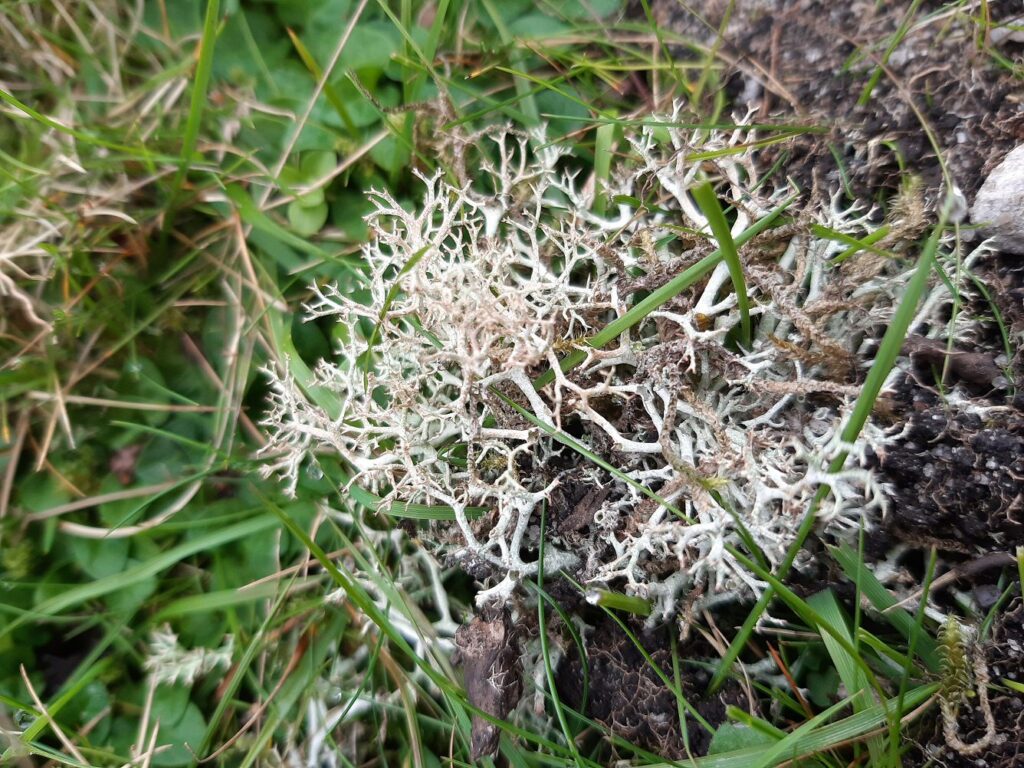
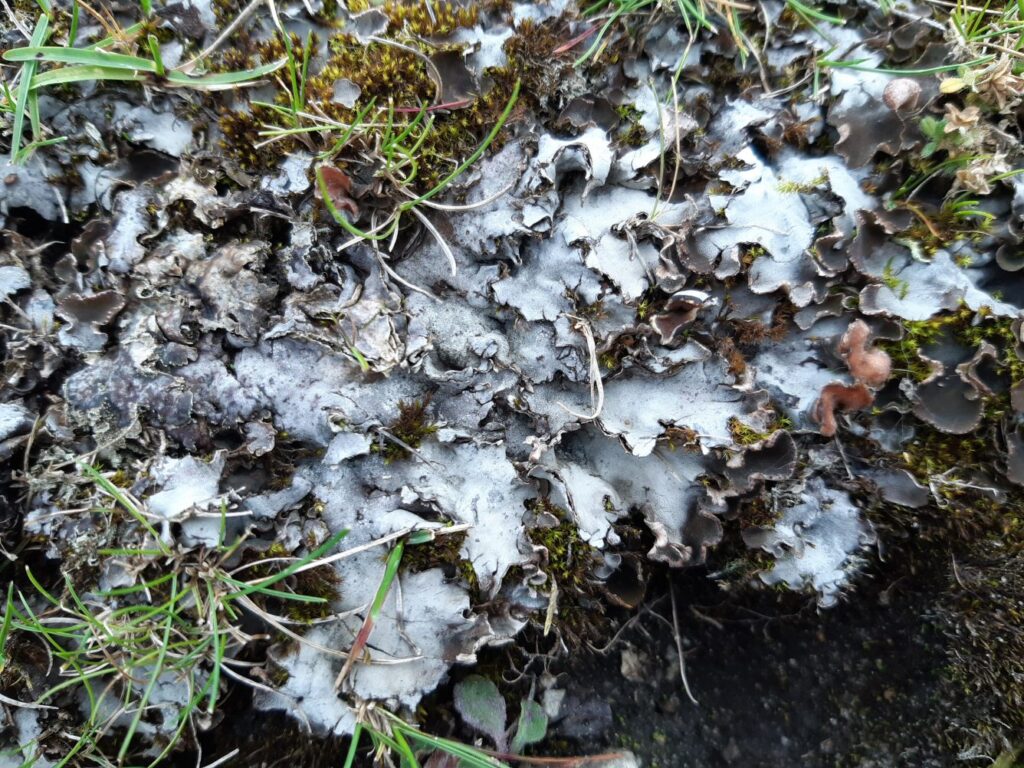
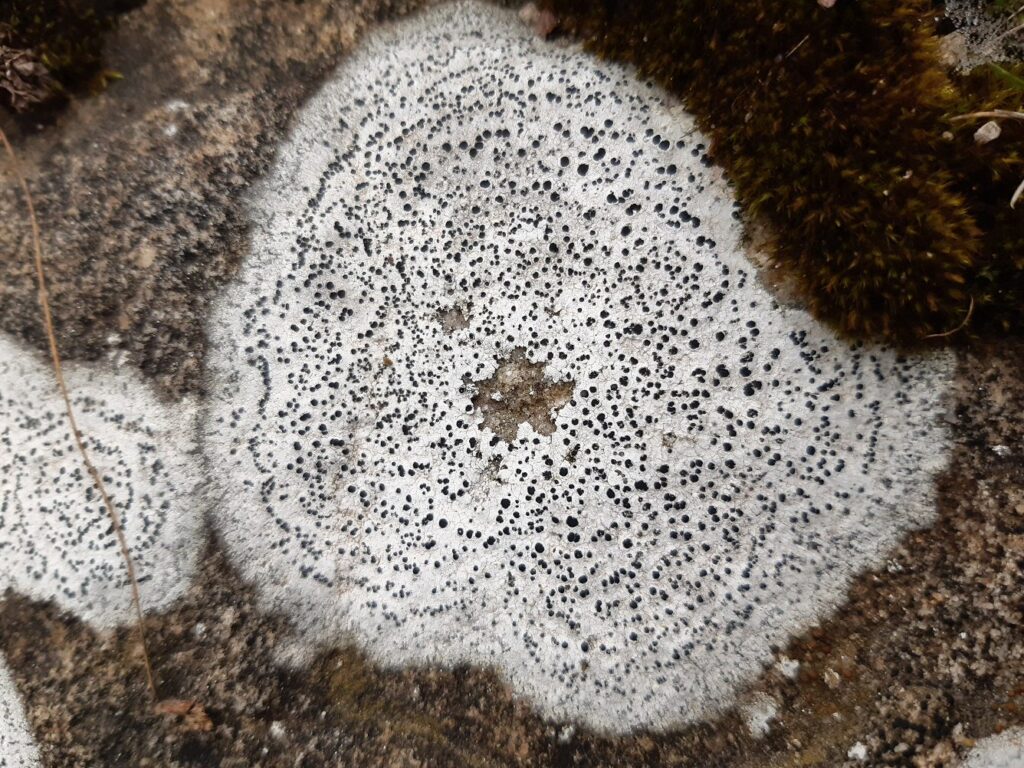
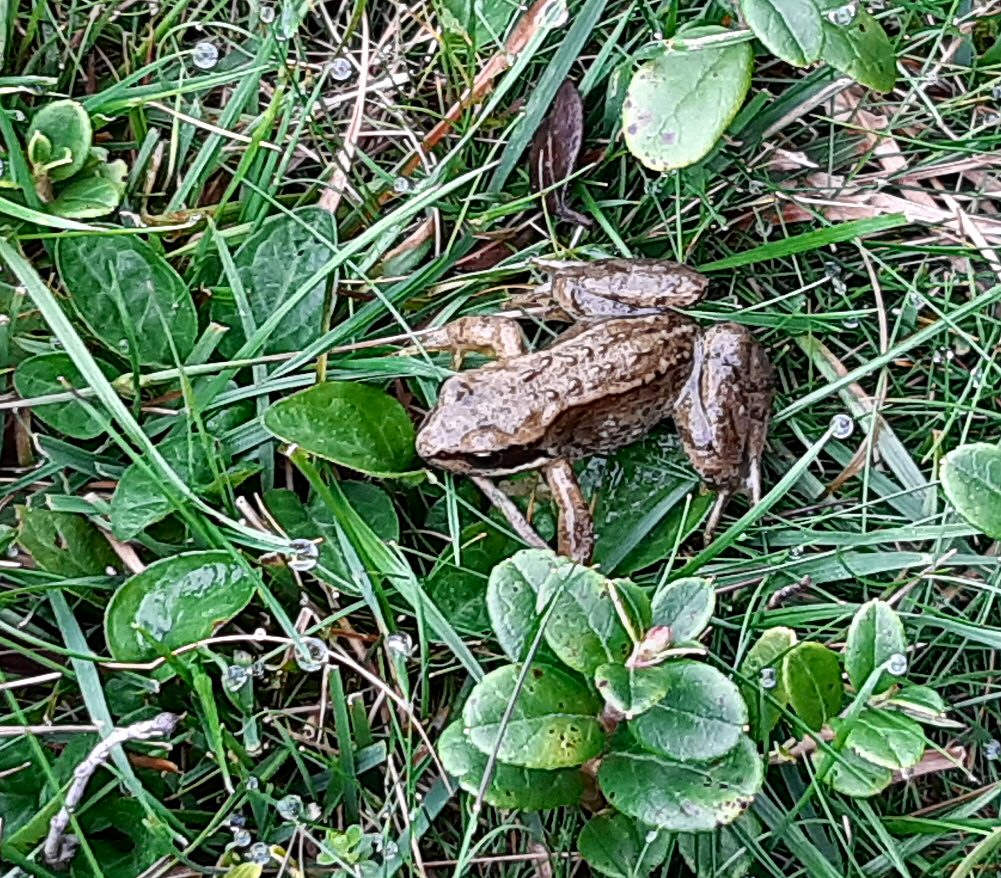

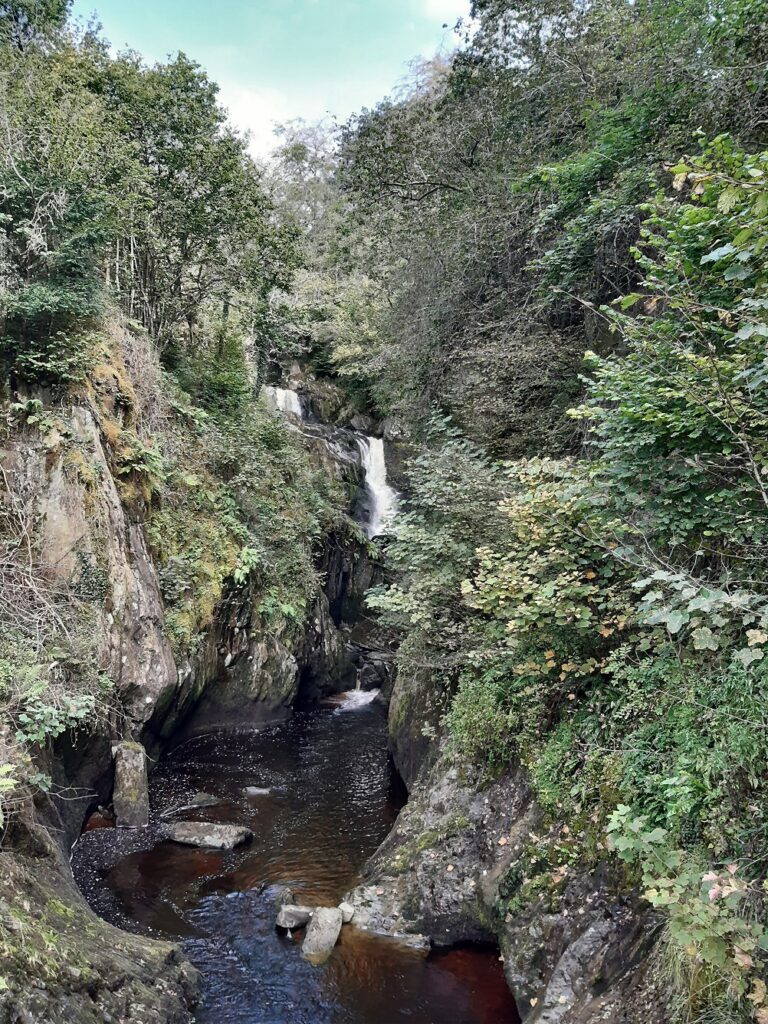
The Ingleton Waterfalls Trail is on private land, with a fee that includes car parking (it was £7 per person when we did it). The trail has been made one-way for the Covid crisis to enable social distancing, so the only current route is from the car park at Ingleton, up the valley and gorge of the little River Twiss, across the windy moor at the top, and down the gorge of the River Doe back to Ingleton. It’s about 8 kilometres, 5 miles, and takes most people about three hours, as there’s quite a bit of uphill walking and a lot to look at, listen to, and photograph, sketch, or paint according to your taste.
Where much of the Yorkshire Dales scenery is (white) limestone, the rocks here also include reddish sandstone and striped bluish or greenish shale and slate. The sandstone is a hard, massive, blocky rock that causes the rivers to run in narrow gorges. The slate, like the slates on many local rooftops quarried from the area, is a hard, waterproof, compressed (metamorphosed) rock that splits into flat sheets at an angle to the layers of mud from which it was originally formed; it forces the rivers into waterfalls. The rocks are up to about 500 million years old.
The walk begins up through the pretty wooded Carboniferous limestone “glen”, with a canopy of Ash trees and undershrubs especially of Hazel. The forest floor is carpeted with Bluebells in wet places, Dog’s Mercury where it’s drier, and plenty of handsome mosses and ferns.
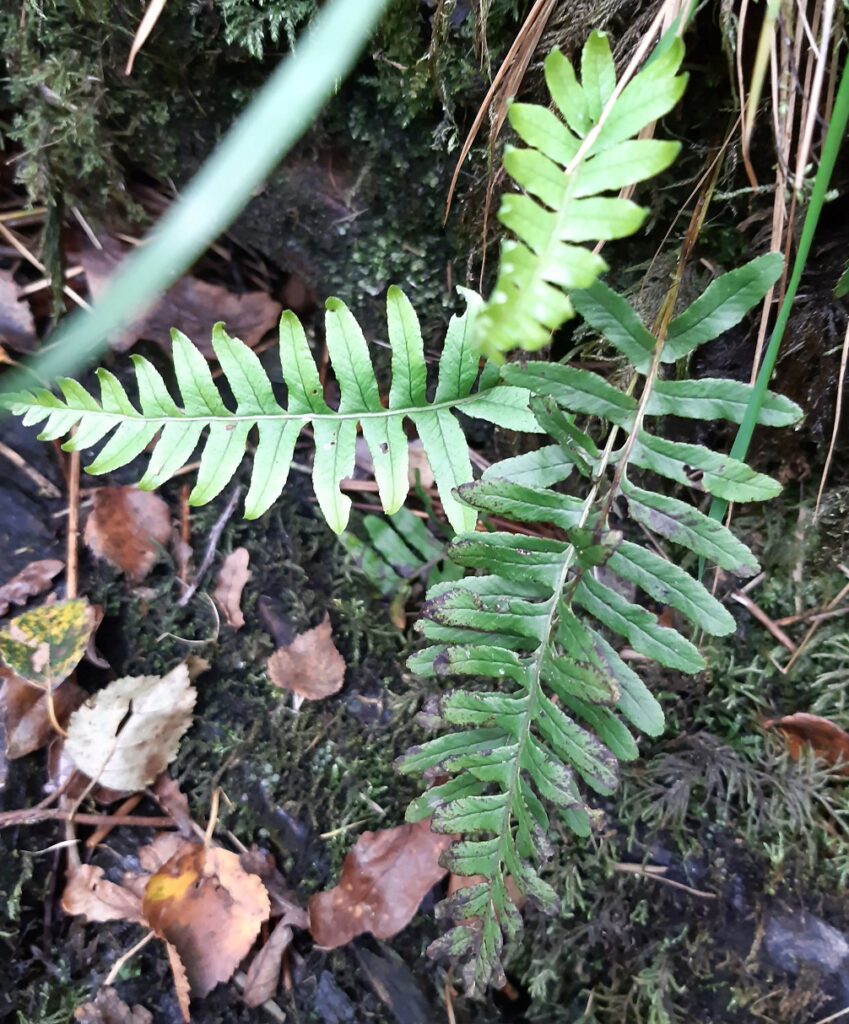
The valley narrows into a gorge, with the river swirling with natural foam in interesting vortex streets against the dark brown peaty water. The foam is created by the action of the waterfalls on soapy chemicals from moorland plants; there is no pollution here.
The five Pecca Falls are already spectacular to eye and ear; I had fun making a video of the rushing water from two converging falls.
Up at the top is Thornton Force — the Norse word for waterfall is “Fors”, so this is another instance of Viking influence, along with familiar local placename elements like Dale from Norse “Dal”, valley and all the towns and villages whose names end in -by, from “By”, village. It is an attractive place for a picnic, sheltered from the wind, with the beautiful fall and nice flat rocks to sit on.
The path climbs out of the now very small Twiss valley, and crosses the open moor eastwards to the valley of the River Doe.
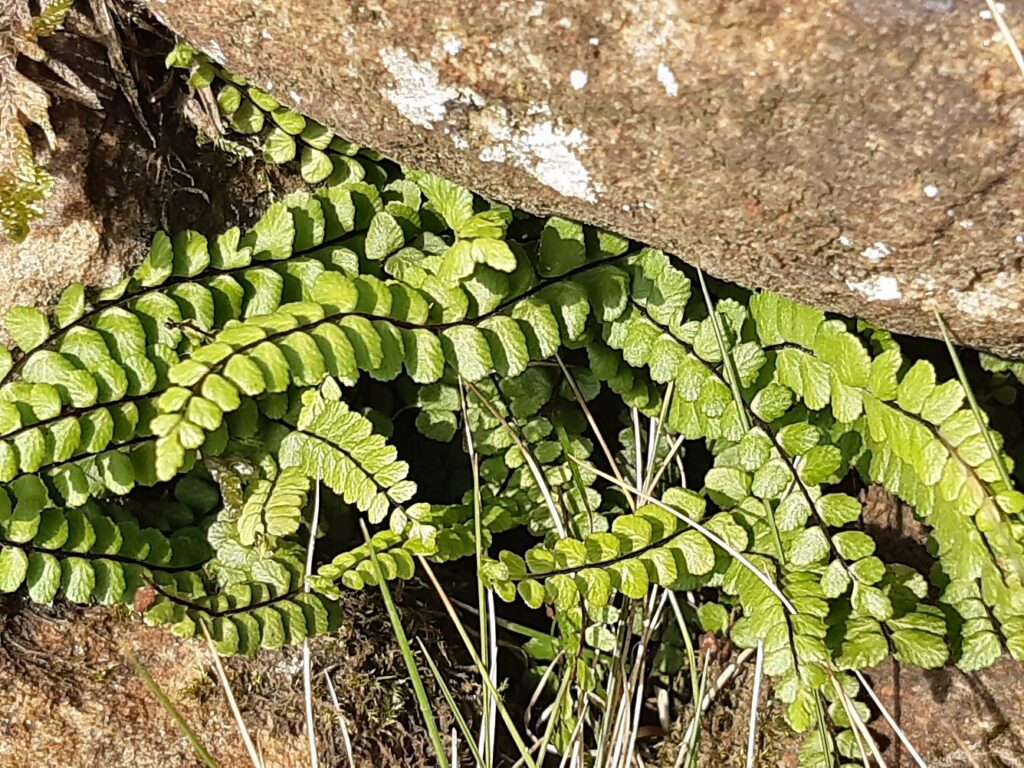
The path winds down quite steeply, while the river is sometimes so deep in its narrow gorge that you can’t actually see down to the water! There are more attractive waterfalls, and several slate quarries: you can see exactly where the quarrymen split off flat slabs of rock.
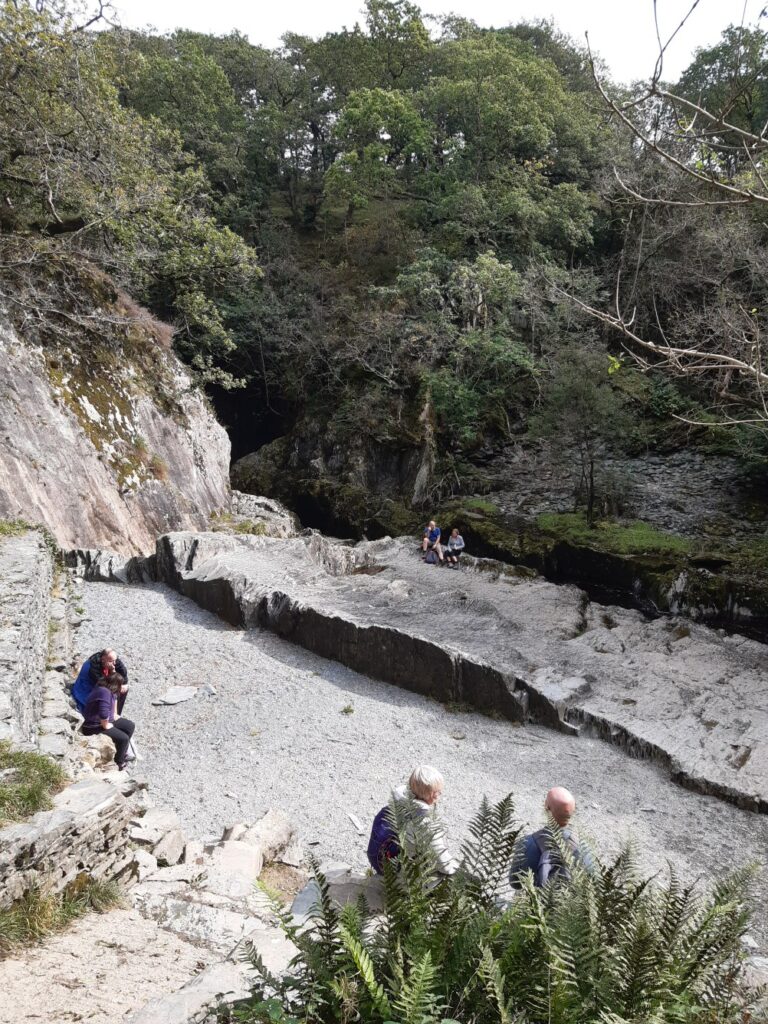
The path drops into Ingleton with its cosy shops, cafes and restaurants, not to mention its impressive but disused railway viaduct high above. Just keep going downhill to cross the river at a low stone bridge, and the car park is right around the next corner.
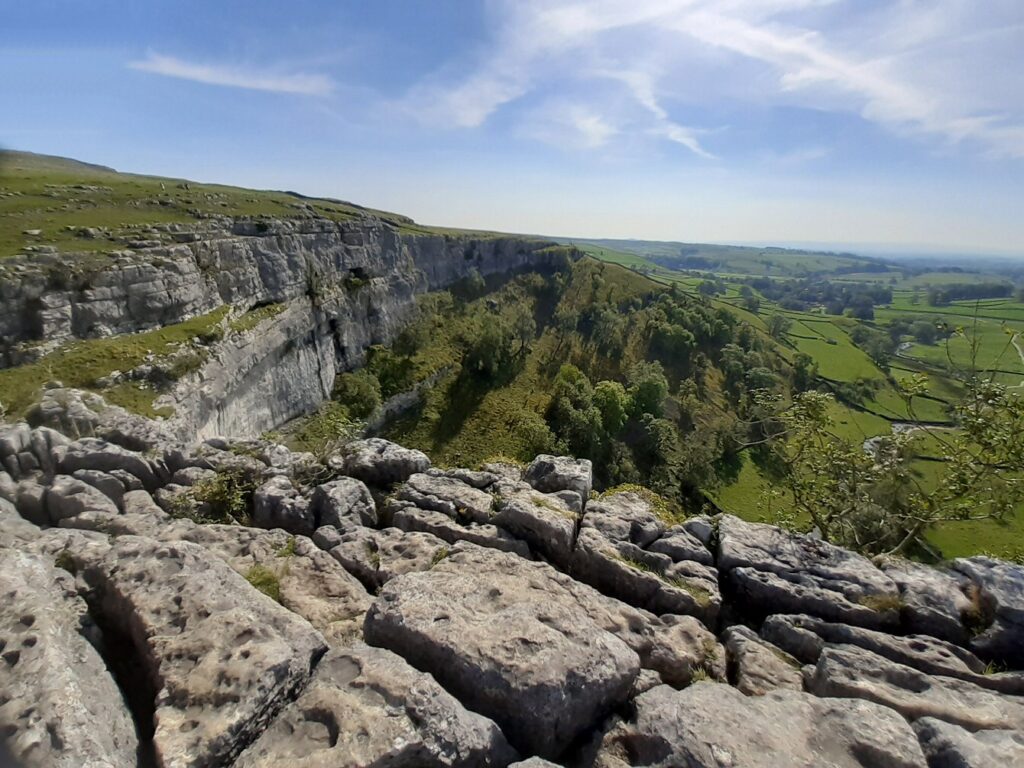
This walk is a loop and could be started from the top, at the car park near Malham Tarn, or the bottom, at Malham or Gordale.
From the Malham Tarn car park, walk a little way westwards along the road across the small stream, and turn left to go southwards on the Pennine Way across the nearly-flat Ewe Moor; the track is well signed all the way. Part of the way you walk gently down a dry valley; there are some short stony sections but with good boots and perhaps a walking pole it’s a delight. After a mile or so, the path takes a bold zig-zag to descent to the top of Malham Cove and its magnificent Limestone Pavement: tiny crustose lichens grow on the hard surface of the clints, and ferns and flowers such as cranesbills flourish in the deep grykes, definitely not places to drop your camera or telephone.
Without taking risks leaning over the vertical cliff, you’ll see the extraordinary sight of the dry waterfall of Malham Cove: during the Ice Age, it was a huge Niagara-sized fall. Actually a small stream emerges at the bottom, but it doesn’t come from straight above but from a different stream that vanishes into the limestone a distance away. In 2015 Storm Desmond briefly resurrected the waterfall, and some lucky people saw the water plunge the whole drop from the smooth overhang.
A gentle grassy path leads eastwards from the limestone pavement (top left of the photo), well back from the cliff edge, and descends gradually to cross the narrow road that winds up the hill (and back to Malham Tarn). The path goes on descending eastwards to Gordale, where it joins the next road just where a convenient ice-cream and refreshments van likes to park. A little way up the road on the left is the well-marked track to Gordale Scar. Its fast-flowing stream is on your left as you walk northwards; gradually you approach the enormous cliffs, until you suddenly round the corner to your right, and you are greeted by the splendid sight of the waterfall in a V-shaped gorge, pouring over a large rock.
If you are adventurous and up for a (simple and short) scramble, you scale the middle of the rock, which has quite big handholds. Once up, you have a delightful walk up the valley and across the moor back to Malham Tarn.
If that is too alarming, you walk back towards Malham Cove, and when you come to the winding road, you follow it for half a mile or so up the hill until you reach the Public Footpath sign on the left; it crosses the moor rather directly to the car park, though in the middle of the moor you have to take the left-hand fork for the shortest way back to your transport.
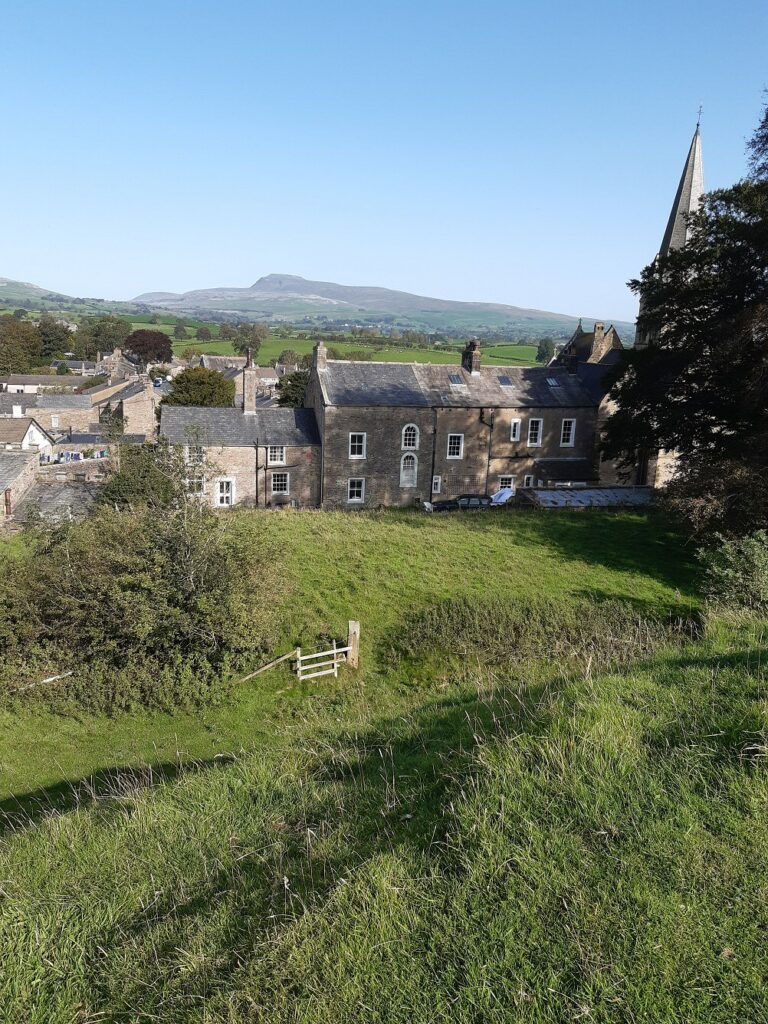
Burton-in-Lonsdale is a handsome stone-built village with history in its name – Burton being Anglo-Saxon for “Fortified Farmstead” or “Farm by the Fort”, Lonsdale including the Viking word (dal) for “Valley”. The fort may have been the Motte-and-Bailey built by the Normans; actually there are two Baileys (fortified enclosures), a big square one to the west, a smaller half-moon shaped one to the south.
The Motte-and-Bailey are at the top of the village: walk gently uphill on the High Street past the church, and along with a high stone wall on your left. After a little while you’ll come to an iron gate in the wall, leading to steps up to the Motte. From the top, a short steep climb up the sheep-nibbled grass, there is a fascinating and beautiful historical view all around; the Motte itself is like a tiny volcano with a circular wall of earth, once topped by a ring of stakes. The two Baileys are clearly visible below, and as the photo shows, there’s a lovely view across the village to the Yorkshire Dales in the distance. The church spire can be seen for miles around.
Walk back to the church, and take the little lane down the hill to the river. Once you’ve crossed the river, you soon come to a crossroads before the road climbs out of the valley. Turn right on to the small lane and walk upstream beside the river. There is a path that continues through the Greta Woods, past Greeta House (it seems the spelling varies) and on up. There is the lovely sound of running water, and dappled light in the woods. Small old quarries are full of ferns and liverworts. At the top, keeping right, you can emerge through a gate into a large steep field of lush grass: the river is far below on your right, with the church spire peeping out from the trees across the river. An ancient grassed-over cart-track runs straight ahead. Follow it until you come to a fence and the corner of a wood. Don’t cross the fence, but descend the grassy slope to the river. At the bottom is a wide flat area that it seems the Scouts use for camps. Turn right and follow the path downstream back to Greta Woods, and return to the village.
The presenters on Radio 4’s PM programme said that we needed an Awesome Nature Walk to lift our spirits during this renewed Covid Lockdown. Happily, we had already planned to go on one, and here it is: an Awesome Nature Walk at Wraysbury Lakes.
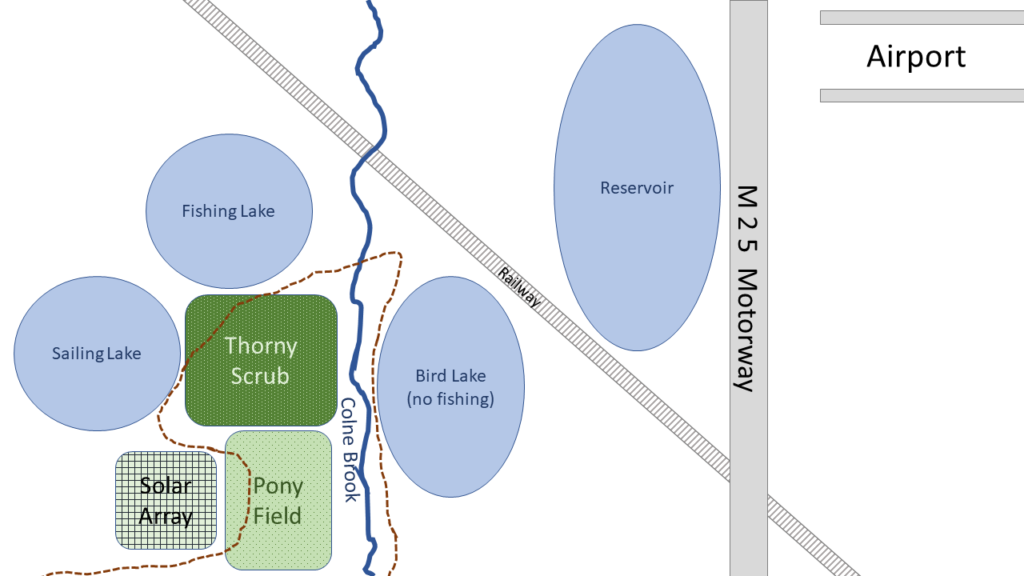
The walk begins near the road bridge over the Colne Brook at the bottom of the map, which is by a repair garage. I’ve drawn the sketch map to give something of the feeling of the route while I’m walking it, rather than attempting to make an objective map.
The area is just outside the M25 ring motorway that informally defines London’s boundary; Heathrow Airport is just inside that, so in normal times (hmm) there is a plane overhead every 90 seconds. Down on the ground, there are numerous lakes which all started life as gravel pits. The River Thames laid down great amounts of sand and gravel in its wide flood plain during the Pleistocene, and the various Flood Gravels now form valuable building materials. Extraction round here has finished, but there are active pits a bit further afield. The pits go below the water table so they fill up by themselves. The large Reservoir is a bit different – it has an enormous high earth bank all around it, so the water level is high above the surrounding ground level (maybe there was gravel extraction there too before the Reservoir was built). A railway runs across the area; it can be crossed at a pedestrian level crossing with a pair of stiles and a lot of looking both ways. To the south of the lakes is an attractive area of thorn scrub with Hawthorn, Dog Rose, Spindle, Bramble and suchlike, with quite a few trees, all very good for wildlife. Down by the lake edges and the Colne Brook are many large Willows and Poplars which grow quickly, lean over, fall, and sprout up anew, forming a constantly-changing cycle of growth and regeneration, and providing cover and roosting-sites for warblers and water-birds.
The lakes have variously been repurposed – one is used by the sailing club, though I more often hear the clatter of rigging vibrating against sail-less masts on windy days than people actually sailing. Another is a strictly private fishing lake, protected by fierce signs and fiercer fences which must have cost a fortune to put up. The lake by the start of the walk is open to wildlife and fishing is forbidden; a delightful trio of icons make it clear that running with a large carp under your arm is forbidden, as is spear-fishing (or is that a black line crossing out a standing fisherman diagonally); frying fish on a griddle is not allowed, though nothing is said about making fish stew in a saucepan, interpret the icon how you will.
South of the scrubland is a pleasantly scruffy pony-field with scattered thorn-bushes and rough grass dotted with tufts of Alfalfa. It rises to a low hill which was once a municipal landfill dump. For some years the dump was grassed over and the ponies roamed all over it; then men came and installed deep pipes to sample and carry away the presumably polluted groundwater; finally, a sizeable array of solar panels was installed and fenced off, complete with security cameras, so ponies and walkers had to make a detour around the array.
So — airport, motorway, gravel-pits, railway, landfill, post-industrial leisure activities, it’s pretty much the classic Urban or Peri-Urban nature area.
The bridge over the Colne Brook offers a glimpse of calm nature; the water babbles softly among the waterweeds, and two Kingfishers dark on triangular wings just above the surface. One swerves into a U-turn, catching the sun to reveal its brilliant blue-and-turquoise plumage. What a moment to start a walk.
We dive gratefully down the few steps from the pavement to the path: the pavement by the bridge is half-occluded by unclipped bushes, and the traffic whizzes past perilously close to unwary walkers.
In the sudden quiet we peer through the trees to the lake. A gang of twenty Cormorants is on the water, with a group of Mute Swans.
The path is bordered with Willows and coarse herbs; a patch of colourful Comfrey, once used to help knit broken bones, attracts some Common Blue Damselflies. At a gap in the Willows, a Cetti’s Warbler sings its abrupt, loud song. Some Migrant Hawker Dragonflies scoot too and fro beside the water, their transparent wings whirring, their long slender bodies glittering blue.
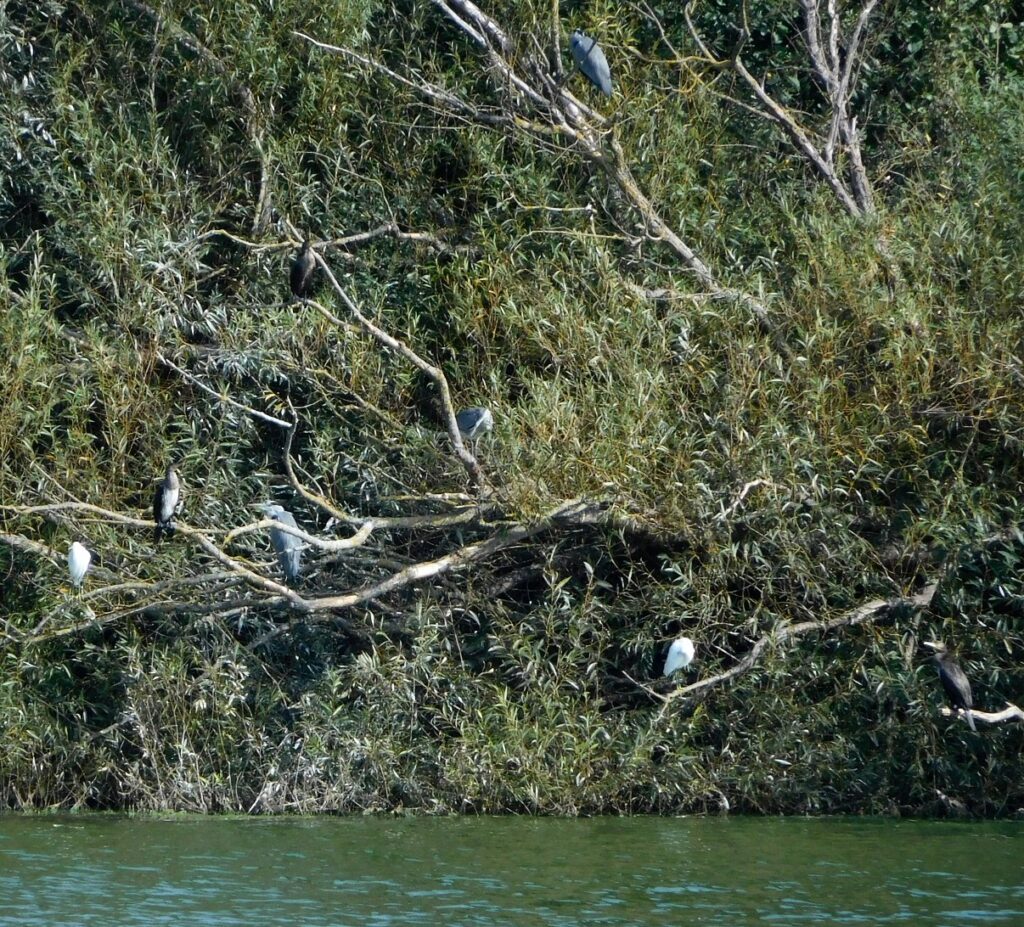
We come to a patch of reeds where we can see right across the lake. A Chiffchaff flits between bushes. On the far side is a bank of Willows, several with protruding dead branches. Perched on these are a few Grey Herons, half-a-dozen Cormorants, and most excitingly three Little Egrets — small white herons with black legs and yellow feet: uncommon visitors here. All of these are predators, feeding on fish and small animals like frogs; the Cormorants fish by diving from the surface, while the herons stand by or in the water, looking out for prey.
The track through the thorny scrub is bright with Rose and Hawthorn fruits — “Hips and Haws” in the fine old country phrase, rich with double entendre, glowing in different shades of red. Across a wide patch of Teasels and Burdocks and Thistles, all tall and prickly in their differing ways, more Hawthorn bushes are still in green leaf but bursting with red fruits, so they are red and green at once, which you might have thought impossible, but there it is, spectacular.
We swing through the kissing-gate and into the pony-field. The animals barely glance at us, the rich grass is clearly far more interesting. “Alfalfa” apparently means “King of Herbs” in Arabic; it was supposedly the finest pasture for grazing animals from goats to camels.
The path rounds the Solar Array; I guess it’s good to know that more and more of our energy is renewable, even if an Electric Vehicle, with its large price-tag, doubtful driving range, and complicated charging arrangements if like me and many city-dwellers, you don’t have a front drive to park and charge it on, is still perhaps a bridge too far. It does feel as if, with one more push, there could be charging points everywhere and affordable prices, and suddenly it’ll look not exotic but obvious. Five years, maybe? Who knows, but at least it’s coming.